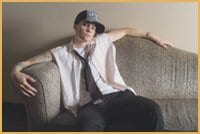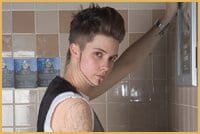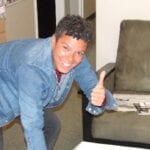
Credit: Shaira Holman photo
Suzan Krieger says she “always ended up” playing a leather jacket-clad greaser with waterfall sideburns when she went into drag mode. It was mostly songs from the ’50s, she remembers. Old school.
She also remembers doing “some stupid song about kissing and hugging in the back seat with Fred;” that Elvis was “a big hit;” and that Crema, of Crema Productions and Chicklets fame, was a dead ringer for Tom Jones.
Krieger pauses, then laughs.
“We did that nun song, ‘Dominique,'” she reveals, referring to the historico-religious 1963 ballad composed and sung by Jeanine Decker, a Belgian nun of the Dominican Order, more popularly known as the Singing Nun —and gay, incidentally.
“We didn’t call them drag kings, but we were doing drag,” says Krieger who, along with Heather Farquahar, once owned the now-defunct Quadra Club that put on genderbending shows circa 1979 with its Quadra Players.
“[That] included women doing women, because a lot of us in the troupe weren’t the most feminine of women, so for us to put on a dress and high heels was going drag, right? We were doing both-gender drag.”
Selecting tunes like “Leader of the Pack” was an excuse to play a guy astride a motorbike.
“I don’t think it was an expression of gender so much as playing it out the way drag queens were playing it out. It was having fun and entertaining ourselves. It really didn’t have a political overtone at all,” Krieger recollects, pointing to the old Lotus Club as the primary nexus of drag king-ing in the post-Quadra 1980s.
When Julie Stines (aka Buster Cherry of the $3 Bill drag king troupe) wanted to break into the scene about a decade later and didn’t know how, she says the only drag king she knew was Crema.
“I said, ‘I want to do that,’ recalls Stines. “And then all of a sudden, there was an opportunity to do it” courtesy of a Lotus “call-out” for those itching to do drag.
By the time she donned an ample Michael Jackson Afro wig and did a rendition of his classic “I’ll Be There,” Stines says she knew she “wanted to do this again.”
But the pickings were slim to none where venues for drag kings were concerned, and Stines had to slowly build her drag repertoire and reputation doing fundraisers before eventually being asked to join a troupe.
Even when Luvia Peterson, stage name Daxx, made her 1997 drag king debut, also at the Lotus, in her grandfather’s pinstriped blue suit —the only thing in her wardrobe that screamed drag —the scene in Vancouver was still in its relative infancy.
“You’d say drag king, and even a lot of women in the queer community would look at you with a blank face, and you’d always have to make a reference to drag queens. Then they’d go, ‘Oh, I get it, so the opposite of a drag queen,’ which it really isn’t. It’s a totally different type of performance, but you had to associate it with something,” Peterson explains.
“Society is that way. What box does it fit in. Now, of course, drag king-ing is its own performance. Back then, it was still very new. There was just a handful of drag kings in Vancouver, if you can believe that.”
Like Krieger, Peterson didn’t see any political messages in the performances when she hit the scene with her interpretation of the Philosopher Kings’ “I Am The Man.” Drag kings mainly just oozed sex in those days.
“The songs were a lot sexier. There was stripping happening. A lot of focus on masculine sexuality. For example, “Blister in the Sun” by the Violent Femmes would have been a number you would have seen, and it would have been done in a sexual way,” Peterson says.
“It didn’t dawn on any of us that we could add a political message, or our own feelings or thoughts about what’s happening in the world. That’s just because the scene was so small, and we were just starting to explore what was possible with drag king-ing.”
For Peterson, who describes herself as semi-retired from the scene, being a drag king was a creative performance outlet that was accessible financially, provided professional and personal validation, and even opened a path to film and television roles —her first acting role being a drag king on the hit series The L Word.
Stines also credits drag for helping carve out artistic, political and sexual space for herself, and thereby a venue to explore her concerns about world peace, racism and queer issues —even as she enjoys taking an all-in-good-fun jab at hyper-masculinity.
Offstage, and still channeling her alter ego Buster Cherry, Stines has had occasion to push the genderfuck envelope too. Like the time Buster ran into some static from a drag queen while trying to access the men’s bathroom at a queer coronation event in Seattle.
Buster’s response?
“You’re wearing a dress, dude. Don’t tell me I can’t go in there. Why don’t you have gender-neutral bathrooms? Look at us, look at you. Give me a break.”
In Peterson’s view, the increasing presence of drag kings is its own form of education, creating awareness about the fluidity of gender boundaries in a variety of contexts.
“What drag king-ing does is it provokes thought. It sets the wheels turning inside the head that, ‘Oh, maybe gender isn’t black and white. This is a woman impersonating a man; or maybe it’s not, maybe it’s an FTM. Maybe there are shades of grey I never thought of,'” Peterson muses. “Maybe they’ll look within themselves too and find there’s a shade of grey in some way, shape or form.”
Krieger couldn’t agree more.
As she looks about the contemporary drag scene, she feels she’s witnessing a sea change in the trends that inform drag king personae and performance.
For one thing, it’s more than just hitting the stage in costume, or appearing as a guy. Today, she says, drag kings are expressing, even personifying, different aspects of gender.
“You see such a diversity of gender, and drag kings are at the forefront of that, showing people that there are all of these different ways of being, different ways of relating, different ways of looking,” she observes.
“As an older person, I kinda feel like it would have been so great to be coming out today, to be 21 today, and have far more choices,” she adds wistfully.
“I’ve talked to many older women too, who say, ‘Oh, maybe I would have considered a transgendered thing.’ So many women that didn’t have those choices that might have made their lives better, or completed them more. Unheard of in the ’50s, ’60s and ’70s,” Krieger declares.
Peterson’s own observations of Vancouver’s drag landscape confirm her belief that “a natural evolution” has taken place.
There are more people coming into the scene trying new things, she says. Not least of which is the opportunity to host and check out the International Drag King Extravaganza (IDKE) —an international conference that brings the largest collection of gender artists and drag king aficionados together for four days of subversive, sexy, campy exploration of gender, sexuality and art in both academic and performance contexts.
IDKE began in Columbus, Ohio in 1999 as a pioneering, one-of-a-kind event. It continued its annual run in that city through 2002, after which it moved from city to city, including Austin, Chicago and Winnipeg.
Bringing events like this to Vancouver exposes local drag kings to new performance ideas and trends while giving them a chance to rub shoulders with other kings from all over the world. It will only enrich this city’s drag culture, Peterson asserts.
Up-and-coming king Chantal Laporte, stage name Majik, remembers IDKE Chicago as the spark that lit her drag fuse.
Her subsequent segue to drag from traditional gender roles in dance was a liberating experience, she says, providing opportunities to create characters that “fit the way my body worked.”
With Vancouver now just days away from playing host to the ninth edition of IDKE, Laporte hopes the conference will give Vancouver’s drag king scene a much-needed shot in the arm as well.
“Right now, we’re sitting kind of low. It was on the rise when I first got into it. A lot of people were getting involved. There were a lot of drag shows,” she says. “And then there was really a need for something else, for something different, a change. Either something new, or performers changing what they were doing.
“There haven’t been a lot of new drag kings, from my experience that I’ve seen in a while,” she explains. “But I think something like IDKE —the Olympics of drag without the competition —is really needed to get people excited about it again, just to be influenced by it and raise the bar a little bit.”
Krieger agrees.
Vancouver may be cutting edge relative to the rest of Canada, she says, but it’s kind of behind the rest of the world.
After experiencing the Austin, Texas IDKE last year, Krieger says she knew “Vancouver needs to see this, to have this thrown right at them.”
She helped form the non-profit society Bent Umbrella, which brought together drag king, burlesque and other queer performers from across the Lower Mainland to develop and eventually win the bid to bring IDKE to Vancouver.
Peterson, also of Bent Umbrella, says she wasn’t sure if Vancouver was ready for something like IDKE since many of the organizing partners had very little, if any, experience working with and among each other.
“I was like, ‘How are we going to get all these great, talented individuals in the same room and work together? I’m happy to say we did. We sat in the room with all our differences and we’ve been able to work together. That’s been the most exciting thing in the whole process,” she says.
“Basically, IDKE is going to sweep in for four days and leave behind it a more educated, more enlightened group of performers and audience members.
“And we’ll be better for it afterwards.”


 Why you can trust Xtra
Why you can trust Xtra


